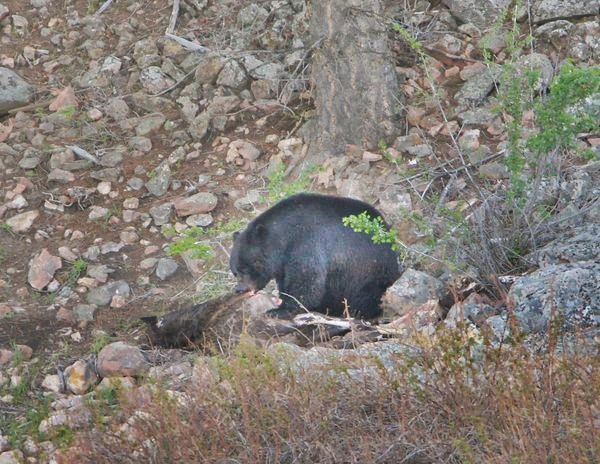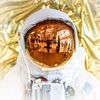Photographing a dark looking subject - need advice
Jun 15, 2015 13:07:26 #
Jun 15, 2015 14:11:30 #
wapusk wrote:
We came across a very dark black bear at Yellowsto... (show quote)
HI. I shoot to get the exposure "in the ball park" so as to speak, and rely on LighRoom to tweak. The odds are that very few shots will be perfect on any shoot. Specifically in your case, you will in LR have a large range in the shadow slider to perfect the dark contrast areas of the bear. I shoot fast as not to lose the action, while adjusting. I take lots of shots, each time looking at my histogram for reference. I shoot in Manual and RAW to assure the best exposure possible. In most instances it is all about eye training, to see the important parts of the shot to know what has to be good exposure. Use spot metering, or learn how to point the exposure box in your view finder to a "darker" area on the same plane as the subject, hold shutter half way, then re-frame. This is a quick way to change the metering so that the bears fur will have more bright areas. You are essentially fooling the cameras metering. If this is not a technique you want then set your menu to bracketing.
Jun 15, 2015 14:51:04 #
wapusk wrote:
OK modern...what is my second question??? Know I am really showing my naïveté
I think you mentioned futzing around with iso... I would set the iso on auto, and use manual for aperture and shutter so the bear's movement doesn't compromise focus.
Jun 15, 2015 16:00:58 #
Karl Shuffler
Loc: Weinert, Texas
According to dpreview testing Tamron SP 150-600mm F/5-6.3 DiVC USD lens, the sharpness is at 150 mm, and progressively decreases as you zoom, by 600 it isn't sharp at all.This is what I suspected to be the problem as well as being 6.3 wide open at 600. Only because you have higher ISO levels will allow better usage at such large apretures. Therefore if better sharpness is an objective, better glass is your only option with such range. At a level of 600 mm., a 300/2.8 plus a 2X converter would be that better option, if your wallet permits. As to the Sony A500, like anything in the real world when buying, you get what you pay for.That being said, considering what was use in the results, you did great. The first system, even before AF lenses I was involved with Minolta system. From SRT-101 to and including Minolta 9Xi I had a collection of Minolta mount lenses which included, third party lenses. So some time back I bought the Sony A-350. Two reasons for that purchase was, put back to use those Minolta mount lenses and second the discontinue price I paid. Good pictures were made, but never great ones I get with higher cost lenses, and more advanced camera being offered today. However; with the camera you do have using,better glass,will make your photo shine better than ever. Choice between spending money for either new camera vs better glass? Having limit funds; do so with glass. It's the glass that makes the difference, between the two.
Most camera most of the time represents more bells and wissels. Even then back in the heydays of film better glass by Minolta made a difference. That ruling still applies. Take what you have and learn all you can about the following: f-stop, shutter speed, ISO setting, white balance, compensation, lighting, photographic equipment, but most of all. Practice, practice, practice. The more bad photos one takes, the more good ones are acquired. Hope this helps as to happy shooting.
Forgot to mention having a crop sensor increase the good, the bad, and the ugly in ones photos. When shooting with any lens handheld, that shutter speed should be at or faster than the focal length being used. Therefore if at 600mm. x 1.5 = 900mm. Then one should shoot at 1/1000 sec. Or faster.
Most camera most of the time represents more bells and wissels. Even then back in the heydays of film better glass by Minolta made a difference. That ruling still applies. Take what you have and learn all you can about the following: f-stop, shutter speed, ISO setting, white balance, compensation, lighting, photographic equipment, but most of all. Practice, practice, practice. The more bad photos one takes, the more good ones are acquired. Hope this helps as to happy shooting.
Forgot to mention having a crop sensor increase the good, the bad, and the ugly in ones photos. When shooting with any lens handheld, that shutter speed should be at or faster than the focal length being used. Therefore if at 600mm. x 1.5 = 900mm. Then one should shoot at 1/1000 sec. Or faster.
Jun 15, 2015 16:39:26 #
Thank you canon lee. I shoot RAW + JPEG so that I can do more post in RAW. I will play more with the RAW files.
Jun 15, 2015 16:41:00 #
Jun 15, 2015 16:47:57 #
Thank you rpavich. The bear was in a shaded area whereas I was standing in the remaining sun so your comment on bracketing exposure is useful. Adding it to my list :)
Jun 15, 2015 16:56:02 #
Thank you Karl. Buying the Tamron was my first "big" investment and everything I read indicated it was a good buy for a first super telephoto. Overall I have been happy with the lens but this latest trip really tested the limits of the lens. I have images of grizzly and wolves at a far distance. The images are OK but not what I hoped for. From what you are saying, adding an extender will not help that much with this lens.
Jun 15, 2015 19:05:31 #
wapusk wrote:
We came across a very dark black bear at Yellowsto... (show quote)
Situations like this scream for using your camera's spotmeter, reading the bear, and UNDER exposing by 2/3 to 1 stop. Using the reading as is will result in a middle gray toned bear, and everything else overexposed. Underexposing the bear a little bit will put the bear with all of the texture of its coat, in the right tonal value. Dialing in exposure compensation and using matrix metering is fuzzy and vague - better to zero in on the thing that is important and expose for it correctly.
Jun 15, 2015 19:41:11 #
wapusk wrote:
We came across a very dark black bear at Yellowsto... (show quote)
i lighten it up a bit, could i upload it to you...
Jun 15, 2015 19:51:29 #
rpavich wrote:
It doesn't matter what color your subject or back ... (show quote)
It's the old "black cat in a coal bin" conundrum. A classic metering problem. As above exposure bracketing is the ony way to get this particular exposure right. As many old film camera users know meters are all designed to meter 18%grey ( the light value of Caucasian skin). That convention was invented by Kodak to get portraits right. (yeah I know that this is perhaps racially biased) but there it is anyway
Jun 15, 2015 19:58:27 #
joe west wrote:
i lighten it up a bit, could i upload it to you...
Hello Joe west. You can upload or just put it in the thread. I am sure others would like to see the result too. Thanks.
Jun 15, 2015 20:01:43 #
wapusk wrote:
Hello Joe west. You can upload or just put it in the thread. I am sure others would like to see the result too. Thanks.
ok here's a lighten up version of yours hope you like it

Jun 15, 2015 22:17:35 #
Gene51 wrote:
Situations like this scream for using your camera's spotmeter, reading the bear, and UNDER exposing by 2/3 to 1 stop. Using the reading as is will result in a middle gray toned bear, and everything else overexposed. Underexposing the bear a little bit will put the bear with all of the texture of its coat, in the right tonal value. Dialing in exposure compensation and using matrix metering is fuzzy and vague - better to zero in on the thing that is important and expose for it correctly.
:thumbup: :thumbup:
Jun 15, 2015 22:21:37 #
wapusk wrote:
Mdorn: thank you for the tip about keeping ISO the same.
Btw... I didn't recommend to keep iso the same.
If you want to reply, then register here. Registration is free and your account is created instantly, so you can post right away.






